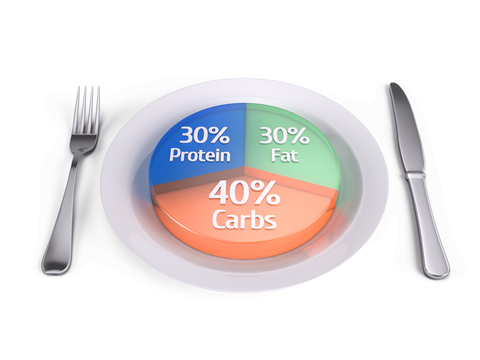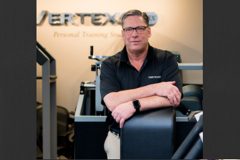To Macro Or Not: Should You Track Your Macronutrient Intake?
As if counting calories isn’t stressful enough, there’s a diet trend that’s gaining popularity among Cross Fitters, bodybuilders, models and social media enthusiasts seeking a leaner physique, tracking your macronutrient intake.
If It Fits Your Macros (IIFYM), also called Flexible Dieting, requires you to calculate and monitor not only your daily calorie goals to lose weight, but also the calories you’re getting from each of the macronutrients (macros): carbohydrates, protein and fat. This requires using a smartphone app or spreadsheet every day to stay on track.
What Macronutrients are and why they matter.
Carbohydrates, protein and fat make up our essential macronutrients. They provide the vast majority of our bodies energy in the form of calories, keeping us fueled throughout the day. One important aspect of the macronutrient approach is that it acknowledges not all calories are created equal: 100 calories of candy and 100 calories of broccoli technically provide the same “energy” to your body but are processed very differently. Think about eating 500 calories of ice cream and 500 calories of spinach; these two choices are reflected identically in the counting calories approach but contribute very differently within a macronutrient breakdown.
Metabolically speaking, foods high in protein and fiber keep us feeling full longer, leading to reduced calorie intake. Conversely, foods with high glycemic indexes, such as white bread and cookies, spike our blood sugar for a short time, providing quick energy but leaving us with a “sugar crash” soon after. The speed that carbohydrates hit our system affects subsequent overeating and weight gain. This means it’s much more valuable to choose whole grain carbohydrates that are slowly digested (and often contain fiber!) rather than processed grains.
So, calories don’t tell the entire weight-loss story. But, it’s important to remember that you can’t have macronutrients without calories. Each gram of fat provides nine calories, while protein and carbohydrates provide four calories per gram. Remember that you’re not eating macronutrients just for calories because every macronutrient has a purpose:
- Fats work to slow digestion, provide essential fat-soluble vitamins and have protective anti-inflammatory properties (omega-3s!).
- Protein provides the building blocks for muscle and cell tissue, while also satisfying hunger and improving satiety.
- Carbohydrates provide a quickly accessible form of energy and fiber, which can leave you feeling full longer and slow the absorption of other nutrients (like sugar).
The method of “tracking macros” is based on the intense desire to optimize body weight and composition, and the belief that keeping exact tabs on the food you eat will enable you to meet success. For those who are competing, this attention to detail can be critical in terms of results. While it may seem tedious to many people, for those who are looking for a specific outcome, counting macros has become a common practice.
Lets take a closer look at the pros and cons of tracking macros to decide if this method is right for you.
Pros to Track Your Macronutrient Intake:
Understanding Intake
By tracking your macros over a period of time, perhaps keeping a record of daily intake for a week or two, one can understand exactly what they are eating. This can then be useful in understanding any changes in weight or performance. By comparing this information they can better evaluate the results and make changes to enhance success. Without doing this, one may not understand where they went wrong, what macro balance works best for their bodies, or how to improve their results.
You Are What You Eat
By using this method you will better educate yourself about what you are eating. The old saying “you are what you eat” can teach you a lesson or two. By “tracking macros” you will be able to gain a greater education about what nutrients you are feeding your body, and where you might be lacking. Additionally, as you learn to recognize portion sizes, understand measurements and read labels, you may ultimately find foods you no longer desire and more nutrient dense favorites all at the same time. This method does have the ability to provide you with a great opportunity to optimize your health, and pay attention to many ways to improve your diet.
Satisfaction
When tracking macronutrient intake it often has you more tuned into the food choices you make, how often you eat and what food is most satisfying. While you are measuring and calculating your intake, there tends to be a greater awareness of what you are eating and how often. For this reason, people tend to learn about their hunger and fullness cues. This often leads to a greater recognition of how to feed your body so that you feel satisfied, and not over full. Even if you are only using this method for a shorter period of time, the long term knowledge of how to satisfy your hunger with a balance of food will come in handy down the road.
Cons to Track Your Macronutrient Intake:
Stressful Thinking
It takes diligent note taking, along with ample time to measure and weigh your food, to accurately track macronutrient intake. It can be very stressful to have to stop and think about what you are eating, as well as critically track its content before it even makes it into your mouth. For those who are not making all of their food from scratch or are just eating at home, this also can be an extra stressor when it comes to figuring out how to calculate foods you may not be preparing yourself.
Quality Versus Quantity
When one is focused on tracking macronutrient intake they often are more consumed with calculations and meeting certain goals for caloric intake, rather than on the actual food. This may cause someone to choose a food solely based on meeting their caloric or macronutrient needs rather than choosing one based on nutritional value. Quite often this results in a caloric intake based on a diet that contains more junk and less nutrient dense foods. Overall this can negatively affect ones health in the long run.
Eating Disorders
For some people, knowing too much can be detrimental. As one becomes more and more focused on calorie counting, precise measurements and weights, and reading labels, eating disorders and unhealthy obsessive thinking can develop. What starts out as a method to reach a health driven goal, can lead to obsessive thoughts and habits. This is often how disordered eating patterns develop where one cannot stop thinking about everything they put into their mouth and start to obsess over it all.
With pros and cons on both side to “tracking macros” what is the right approach to take? Perhaps before embarking on this method it is best to understand your end goals and consider your lifestyle and personality. And remember, ultimately it is most important to lead a healthy life inside and out.
The questions I usually ask in terms of your questions about whether a particular diet/exercise strategy works:
- Is it sustainable?
- Does it make you feel good; energetic and healthy and like your best self?
- Does it interfere with your quality of life or cause you stress? For instance, during a dinner out with friends, would you find yourself stressing out while eating foods that you haven’t had a chance to calculate values for, or don’t know the macro breakdown of?
Consider your answers to these questions honestly & carefully, and then you’ll have a good indication whether what you’re doing is “right” for you.
Tracking what you eat can help you lose weight, but there isn’t any evidence that tracking macros can offer you a greater weight-loss advantage than other calorie-counting diet plans.
With any eating plan, food quality matters. The ideal diet isn’t just about macros; it’s about choosing healthy, whole foods over heavily processed foods. There are healthy and less healthy types of carbs and fats. Focus on getting most of your carbs from fiber-rich vegetables, beans, fruit and whole grains over added sugars or white bread. And when you choose where to get your fat from, nuts and oily fish are better choices than fried foods.
There isn’t a single diet that works for everyone, so seeing a dietitian for individualized advice is a great idea. A registered dietitian, can help you determine that. Nutrition philosophy is similar to flexible eating in that you eat as healthy as possible most of the time and enjoy less healthy treats once in a while. The difference? You don’t have to use spreadsheets or diet apps. It’s about finding the balance that works for you.
Request a complimentary first session at Vertex Fitness, Voted the BEST Personal Training Studio on the Main Line
Click HERE and we will schedule a session to try it yourself








Leave a Comment